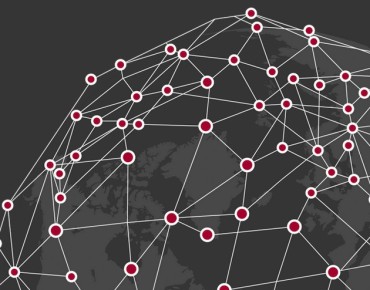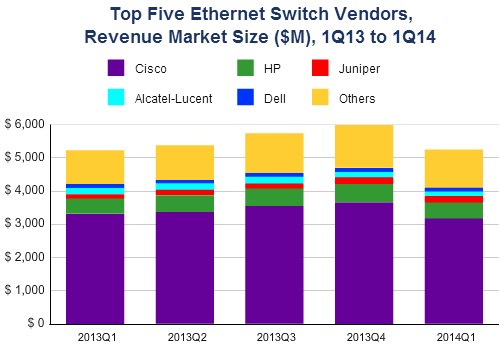Ethernet Switching Sales Soften

The Ethernet switch market just took its biggest sequential dive in a long time, thanks to a confluence of economic forces and technology transitions among the major players.
The box counters at IDC and Dell'Oro Group both gave their assessment of the Ethernet switching space as last week was winding down, and the news is probably going to cause people to wonder about the slow start for Ethernet switching.
To be precise, Dell'Oro Group reckons that the market declined nearly $1 billion from the fourth quarter of 2013 to the first quarter of 2014, with sales just over $5 billion across all speeds across Layer 2 and 3 switches.
"Several factors caused 1Q14 to deliver the second-worst first quarter on record for the Ethernet switch market," explained Alan Weckel, vice president of Ethernet switch market research at the company. "Campus switching continues to struggle as many customers look towards wireless connectivity; data center switching paused as Cisco's Nexus 9000 product transition continued; and stronger than usual seasonality all caused the market to weaken. Despite the steep decline, white box switching continued to gain momentum in 1Q14, outpacing the overall market. As we look towards the rest of 2014, the market will be most impacted by two factors: Cloud providers' continued and increasing need for networking equipment, and how China selects the vendors it will allow to sell into each part of its network."
Dell'Oro Group said that the market for 40 Gb/sec and 100 Gb/sec Ethernet switches grew in the quarter, and added that together they contributed about 5 percent of total switch revenues. (That would by just under $250 million, which is a good start.)
Over at IDC, the box counters believe the market for Ethernet switches was a little bit larger, at $5.2 billion for the first quarter, and while that represented a large sequential decline from the fourth quarter, IDC reckons it is about half the decline that Dell'Oro believes occurred. Year-on-year, IDC says sales were actually up four-tenths of a point in the first quarter for Layer 2 and 3 products; the sequential decline was 12.3 percent.
"The worldwide Ethernet switch market continues to see different trends across market segments with datacenter deployments seeing growth in spite of the ongoing market transition while the enterprise campus segment is essentially flat lining or seeing slight declines depending on the segment or geography involved," explained Rohit Mehra, vice president of network infrastructure at IDC. "10GbE and 40GbE switch ports for the datacenter and campus core remain the growth engine for this market, although we do expect the GbE market to hold its own with port shipments during the coming years."
IDC says that 40 Gb/sec switching is reaching critical mass and in the quarter broke through $250 million in sales. (The company did not provide figures for 100 Gb/sec products.) The big driver of Ethernet sales right now is, of course, 10 Gb/sec switches, which saw an 8.1 percent rise in the first quarter to $2 billion; that represented over 4.9 million ports across all of the switches, a rise of 25.7 percent compared to a year ago. That suggests that the average cost per port for 10 Gb/sec switches has fallen by 14 percent to just over $400 a pop.
Cisco Systems, as you can see from the chart above, continues to dominate the market, but its share is slipping as the rollout of the top-end Nexus 9000 switches, with their baked-in SDN chips and software, take time to build up momentum. Cisco accounted for more than $3.1 billion in sales, down 4.3 percent and it lost more than a point of market share. But Cisco's share in the 10 Gb/sec segment of the space was higher than its overall share, at 62.2 percent, according to IDC. Hewlett-Packard has the number two position in the switching space thanks to its acquisition of 3Com a few years back, and even with that and 4.5 percent growth in the first quarter, HP only has 9.2 percent of the global Ethernet switching pie. Juniper Networks came on very strong in the first quarter, with Ethernet switch sales up 53.4 percent.
Ethernet switching was weak in North America (off 1.2 percent) and Europe (down a half point), but rose a little in Asia/Pacific (up 1.9 percent to be precise) and jumping sharply in Latin America (up 11.4 percent).
The question now is: What is the appetite for Ethernet switching for the rest of the year? The switching market is still less than half the size of the server racket and about the same size as the external storage array business. So for all of this talk about big data and the need for speed on the networks, the money is still carving up about roughly the same.











